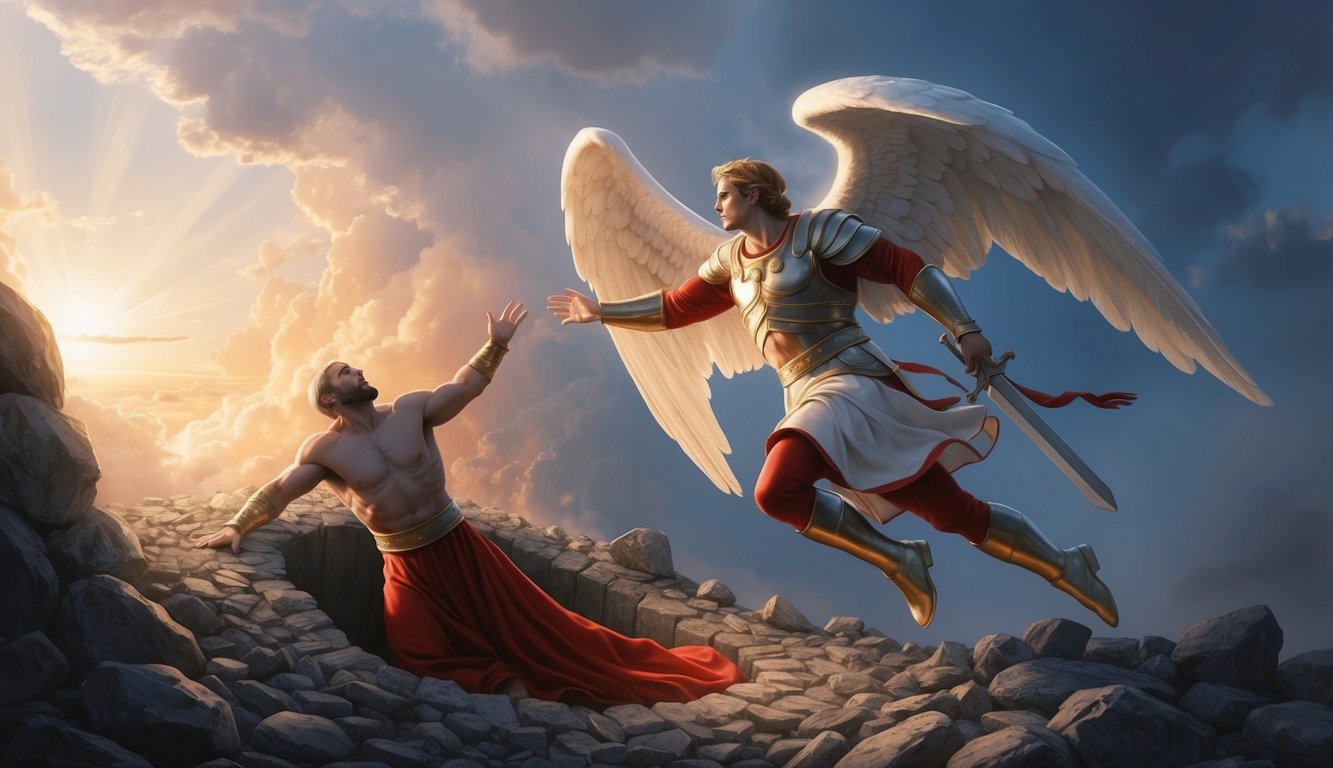Don’t Miss Out On This Unique Astrological Opportunity
Are you tired of spinning your wheels and getting nowhere? Simply put, you’re out of sync: you’re out of alignment with your astral configuration.
But: there’s a kind of map that can help you reclaim your alignment. Think of it as your own personal blueprint to success and happiness: a blueprint that will help you live your most amazing life.
Get started here.
Revelation 20 is a fascinating chapter from the Bible that many people find intriguing.
It describes a series of events featuring the binding of Satan, a thousand-year reign, and the final judgment.
These events capture the imagination and curiosity of many readers, leading to countless interpretations and discussions.
The chapter begins with an angel seizing Satan, symbolized as a dragon, and binding him for a thousand years. This marks a period known as the Millennial Reign.
During this time, those who have remained true in faith are resurrected to reign alongside Christ.
The symbolism within this chapter is rich and stirs questions about the nature of good, evil, and ultimate justice.
As you read further, you will encounter an intense depiction of the final judgment.
Here, the dead are judged based on their deeds.
This moment emphasizes accountability for one’s actions.
The vivid imagery and complex themes make Revelation 20 a captivating part of the Bible that continues to spark discussions to this day.
Key Takeaways
- Revelation 20 features the binding of Satan and a thousand-year reign.
- It depicts the final judgment where the dead are judged by their actions.
- The chapter provides vivid imagery and deep themes about good and evil.
The Millennial Reign and the Binding of Satan
In Revelation 20, you find exciting descriptions of events where Satan is bound, and Jesus reigns for a thousand years.
These moments highlight themes of power, justice, and faith, offering a glimpse into a transformative era.
The Thousand Years
In this period, often called the millennium, Jesus’ reign brings peace and justice to the world. Thrones are symbolic of authority, with souls of believers participating in this rule.
This time is unique because it comes after the first resurrection, where those who remained true to their faith rise to take part in the millennium.
Being part of this era is described as blessed and holy.
Participants become priests of God and Christ, sharing in His glory.
This reign promises a time free from evil influences, illustrating a contrast to their earlier struggles.
Satan’s Binding
An angel sent from heaven undertakes the task of binding Satan.
This angel holds a great chain and comes with the key to the abyss, a place representing confinement.
Satan is seized and cast into this abyss, effectively sealed from influencing the world for a thousand years.
This binding ensures that Satan’s power is curbed, limiting his ability to deceive people.
It symbolizes a time where evil is restrained, allowing peace to thrive.
The act of sealing the abyss serves as protection against chaos and further deception, making it a significant event in maintaining moral order during the millennium.
The Judgment of the Dead
In Revelation 20, the judgment of the dead is a vision where everyone, regardless of their status or where they died, stands before a throne for their deeds to be evaluated.
The Great White Throne
You picture a grand scene with a great white throne.
This throne represents the ultimate seat of judgment.
People from every corner of the earth gather before it.
They are not separated by age, rank, or wealth—everyone is equal here.
Death and Hades, the symbolic domains where most of the deceased rest, are seen giving up their dead.
No one can escape this gathering.
The image is one of awe, emphasizing the seriousness of this moment.
The Books of Judgment
Several books are opened here.
These books contain records of everyone’s actions.
Your deeds are measured, whether they’re good or bad.
Along with these is the important Book of Life.
The sea, and symbols of death and the afterlife, release all the dead so they can be judged too.
This underscores the completeness of this judgment.
If someone’s name is not found in the Book of Life, they face the second death, being cast into the lake of fire.
The Final Battle and Satan’s Doom

In this dramatic conclusion, Satan is released after a thousand years to deceive the nations and gather them for a final battle.
The uprising of Gog and Magog leads to an epic confrontation, but their efforts are crushed as fire consumes them, marking the end of the devil.
The Release of Satan
After a millennium in prison, Satan is released once again.
This moment is significant as it sets the stage for the final events.
His release is meant to test the nations anew, showing that even after a thousand years of peace, the potential for deception remains.
You see how Satan’s freedom is temporary and purposeful.
He exits his prison, aiming to wreak havoc.
This serves as a reminder of the ongoing cosmic battle between good and evil.
The release highlights Satan’s persistent ambition to lead the world astray.
Gog and Magog’s Uprising
The names Gog and Magog often symbolize widespread rebellion against righteousness.
Upon his release, Satan gathers these nations for an uprising.
They are described as numerous, like grains of sand, showing the strength of their numbers.
The group surrounds the camp of God’s people, as if poised for victory.
Yet, Satan’s deception draws them into a futile fight.
The uprising underscores both the power of deceit and the enduring faith of those who stand with God.
Fire from heaven quickly consumes them, ending the rebellion and demonstrating divine intervention.
You witness the futility of opposing divine will.
The Devil’s End
With the uprising crushed, the devil’s fate is sealed.
This is the ultimate defeat for Satan, marking the end of his destructive influence over the world.
The imagery here is vivid: Satan is captured and thrown into the lake of fire, where he is tormented forever.
This moment is critical because it signifies justice and the final cessation of evil.
Seeing the devil’s end reassures you of the lasting triumph of good over evil.
It’s a closure not just for the characters involved, but a promise for all believers.
Frequently Asked Questions

Revelation 20 is rich with symbolism and prophetic imagery.
You’ll discover insights into the “thousand year reign,” the “first resurrection,” and the “Great White Throne Judgment. ” This chapter highlights the ultimate defeat of Satan and the final judgment of all mankind before God.
It serves as a reminder that divine justice will prevail, fulfilling the promises found throughout Scripture. In the beginning was the Word, and this eternal truth underscores the authority of Christ in both judgment and redemption.
What does the ‘thousand year reign’ refer to in Revelation Chapter 20?
The “thousand year reign,” often called the Millennium, suggests a period where Christ reigns on Earth.
People have different views about whether this reign is literal or symbolic.
The idea is that this will be a time of peace and justice on Earth.
How is the ‘first resurrection’ described and interpreted in Revelation 20?
The “first resurrection” is viewed as a revival of believers who have died in faith.
This spiritual resurrection symbolizes overcoming sin through faith.
Some interpretations link it to a spiritual awakening or renewal experienced by believers.
In what way does the ‘Great White Throne Judgment’ in Revelation 20 affect all of humanity?
The “Great White Throne Judgment” is where everyone is judged by God.
According to Revelation, those whose names are not found in the Book of Life are cast into the Lake of Fire.
It’s a significant event signifying ultimate accountability before God.
Can you explain the symbolism of the ‘Lake of Fire’ in Revelation 20?
The “Lake of Fire” represents the final destination for those who oppose God, including death and hell.
It’s depicted as a place of eternal punishment.
Some see it as symbolic of complete separation from God.
What is the significance of ‘Satan being bound for 1000 years’ as stated in Revelation 20?
When Satan is bound for 1000 years, it represents a time where his influence is limited.
This allows for the spread of the Gospel and peace throughout the Earth.
This binding is a part of Christ establishing his reign.
How do Revelation chapters 20 and 21 connect in describing future prophetic events?
Chapter 20 sets the stage for new beginnings in Chapter 21.
After the judgment, Revelation 21 introduces a new heaven and a new earth.
These chapters together describe the transition from God’s final judgment to the establishment of eternal peace and joy.



